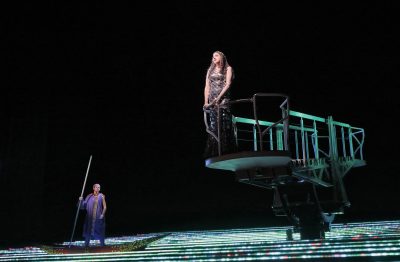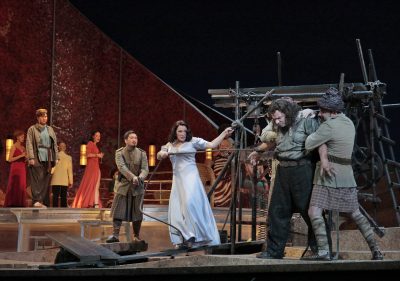Love and Lust, Near and Far
|
Grant Chu Covell [January 2017.]
Tamara Mumford as the Pilgrim and Susanna Phillips as Clémence in Kaija Saariaho’s L’Amour de Loin. Photo by Ken Howard/Metropolitan Opera. As a Christmas Eve grouping, L’Amour de Loin and Salome are an unthinkable pair, but those were the operas on the roster this past December 24, 2016. Contrasting the two is inevitable and perhaps too easy, so I will consider them separately. Kaija Saariaho’s L’Amour de Loin was premiered in Salzburg in 2000. It is her first opera, and it lasts approximately two-and-a-half hours. There are but three characters. Jaufré Rudel, the Prince of Blaye, is a bored troubadour imagining that there must be more to life. He yearns for an ideal woman to love. A Pilgrim suggests that such a woman exists, but far away. This woman is Clémence, the Countess of Tripoli, and the Pilgrim becomes their go-between. Rudel decides to see Clémence, but as he approaches Tripoli, he becomes terrified that reality may not live up to his ideal. Clémence feels similarly. As would be expected in an opera, the prince becomes ill on the journey. The lovers meet, they declare their feelings and embrace, but Rudel dies. Clémence finally shows a bit of passion and becomes determined to renounce her life and enter a convent. Rudel was a real 12th-century figure, and librettist Amin Maalouf and Saariaho incorporated his poems into the opera. The composer’s first exploration of this material was with Lonh (1996), for soprano and electronics, which sets Rudel’s words (“lonh” is old Provençal for far away or distant, or modern French “loin”). There is not much drama in L’Amour de Loin (https://www.lafolia.com/armchair-operas-5/). Or it can be said that the drama hinges upon subtle changes in mood and emotion. Similarly, the music, although constantly changing and wonderfully orchestrated, is cut from consistent cloth. Despite the translucence, languorousness pervades, dispelled only in Act IV’s storm music. Saariaho’s colors and use of electronics reflect her alliance with the Spectralists, Gérard Grisey, Tristan Murail, and Hugues Dufourt especially, and to a lesser extent Horatiu Radulescu. This production endured because of the staging. Ribbons of LED lights were strung across the stage which pulsed and flared to simulate the ocean. A teetering staircase (a hybrid of airplane stairs and astronomical telescope) pivoted and swung to suggest balconies and docks. The Pilgrim appeared on a simple skiff. Sometimes there were puppets at the rear of the stage to suggest distance. Dancers were lifted mid-stage indicating motion across the sea. The chorus would appear rooted in place as the horizontally stretched ribbons of light raised and lowered around them. There were no electronic lights or mechanical gangways in the 1100s, but the atmosphere was otherwise consistent. My first experience with Saariaho’s music was Nymphéa (1987) for string quartet and electronics (Montaigne MO 782141 with the Arditti String Quartet). A later representative release from 1977, Ondine ODE 906-2, includes Près (1988) for cello and electronics (with Anssi Karttunen) and Lonh (with Dawn Upshaw). Two further pieces surrounding L’Amour de Loin’s creation and exploring the same material are far more digestible because of the scale: Cinq Reflets (2001) for soprano, baritone and orchestra, and Oltra Mar (1998-99) for chorus and orchestra, both on Ondine ODE 1049-2. As fantastic as are Saariaho’s colors, electronics, and kinetic motion in smaller doses, the two-and-a-half hour opera span can be quite a mission. No fault rests with the Metropolitan Opera Orchestra, conducted by Susanna Mälkki. Astonishingly, Mälkki is only the fourth female conductor the Metropolitan Opera has seen. Similarly surprising, L’Amour de Loin is but the second opera written by a woman that the Metropolitan Opera has staged (the first was the one-act Der Wald by Ethel Smyth, presented in 1903). In the December 24th L’Amour de Loin production, Michael Todd Simpson stepped in for Eric Owens to play Rudel. It was hardly the untested work of an understudy. I have not seen Owens in this role, but Simpson was confident and faultless. Perhaps he has an astonishing ability to learn parts quickly, or else he has been working diligently on this one. Susanna Phillips (Clémence) appeared completely comfortable working with Simpson for the few moments they actually appear together. Tamara Mumford was the Pilgrim who sets the intercontinental plot into motion.
Patricia Racette in the title role and Željko Lučić as Jochanaan in Strauss’ Salome. Photo by Ken Howard/ Metropolitan Opera. If L’Amour de Loin is introverted and subtle, Salome is outlandish and messy. Strauss’ 90-minute bolt premiered in 1905, derived from Oscar Wilde’s scenario. This production opened on an odd mix of desert military camp at one side and formal cruise ship on the other. Herod’s party is down below, the soldiers at ground level are in awe of their prisoner Jochanaan (John the Baptist), and then Salome wanders through messing everything up. Perhaps the formal wear, aluminum platforms, wicker chairs and machine guns were meant to conjure a random Imperialist outpost back when there were Empires. But conflicts and breaking norms is what Salome is all about. She wants what she can’t have, or in this case, the prophet Jochanaan (Željko Lučić) who utterly rejects her. Unlike other Salomes I’ve seen, the ensemble acting was fantastic, especially as the singers must dart between heightened states: Narraboth (Kang Wang), the love-struck but ignored Captain of the Guard, is driven to suicide; Herod (Gerhard Siegel) vacillates between awe and disgust, titillation and indecision; Herodias (Nancy Fabiola Herrera), if she’s not taunting or encouraging her daughter, is in a drunken stupor. As a dominant Salome, Patricia Racette took the famous dance to its logical conclusion. The evening I saw it, as the audience realized what was about to happen, a woman shouted “What the fuck?!” It seemed the whole house was startled by the nudity as well as by the audience reaction. I recall the story of Strauss playing through the whole opera for Mahler, who thought the Dance of the Seven Veils incredibly crass and a miscalculation. However, Strauss knew what he was doing. The opera’s climax occurs after Salome caresses Jochanaan’s severed head, and Strauss deploys a particularly grotesque chord that perverts the appearance of several themes. The entire opera prepares for that particularly dissonant moment, and conductor Johannes Debus (Salome is his first production at the Metropolitan Opera) ensured there was clarity and precisely the right balance of vulgarity and gorgeousness.
[More Grant Chu Covell]
[Previous Article:
Piano Factory 18.]
[Next Article:
Beethoven and Schnittke in Boston with the Danish String Quartet]
|

